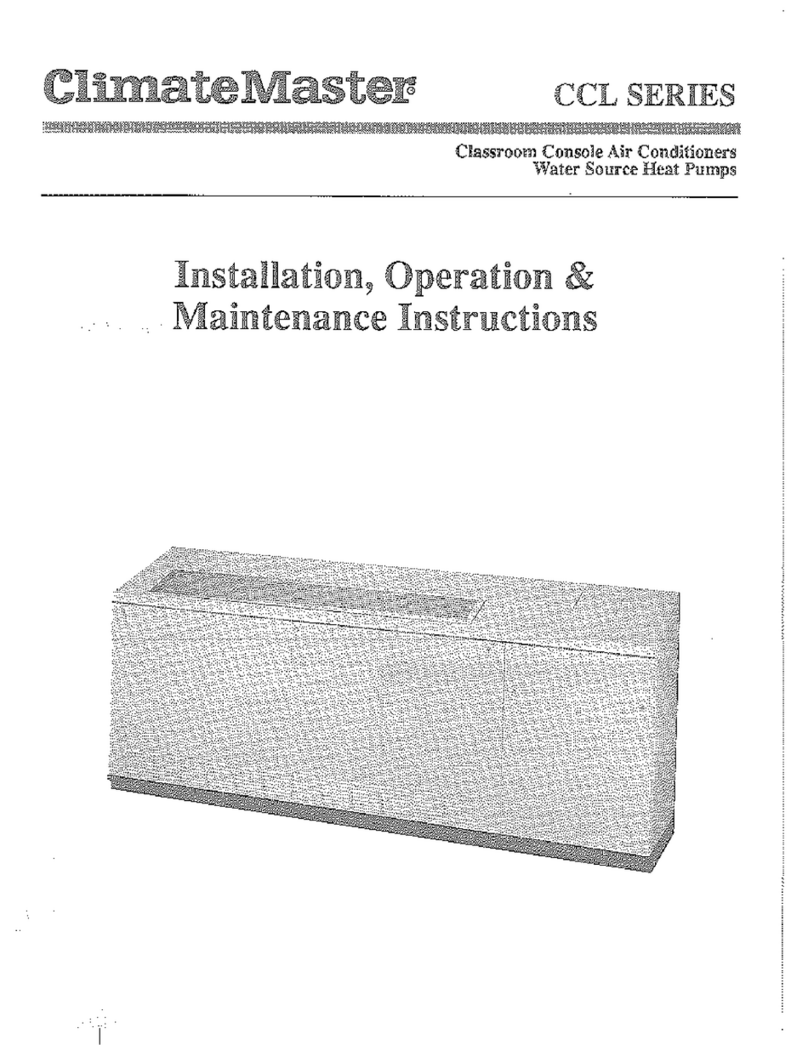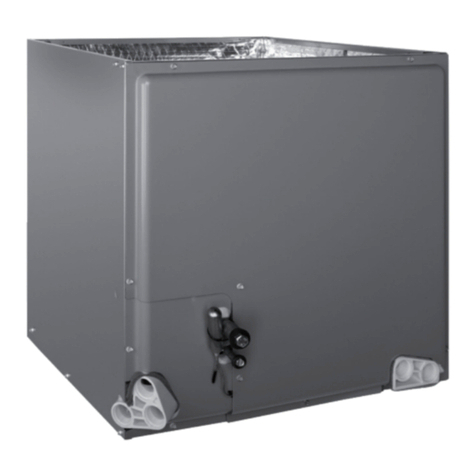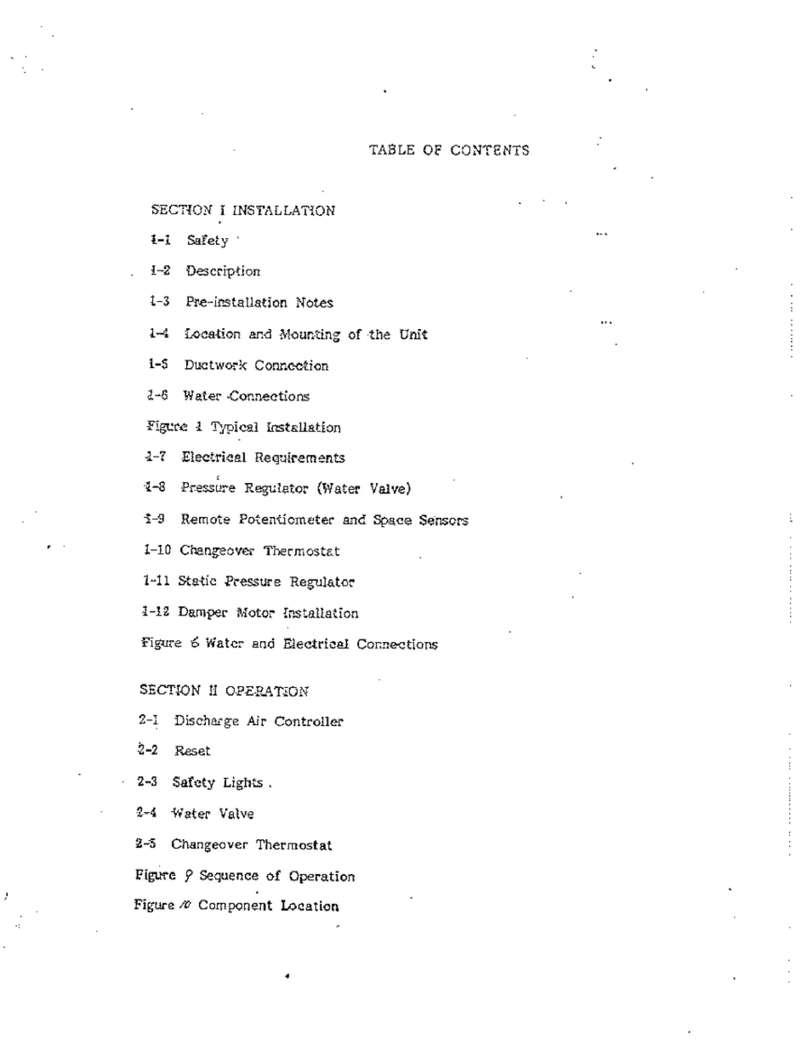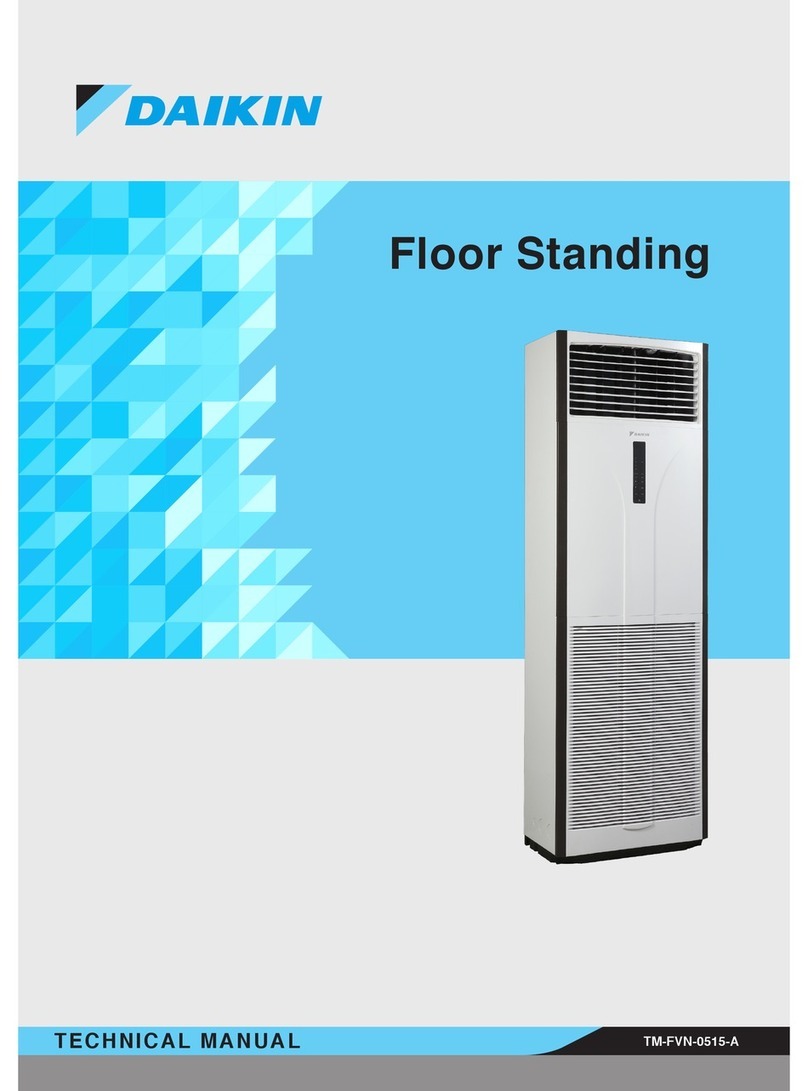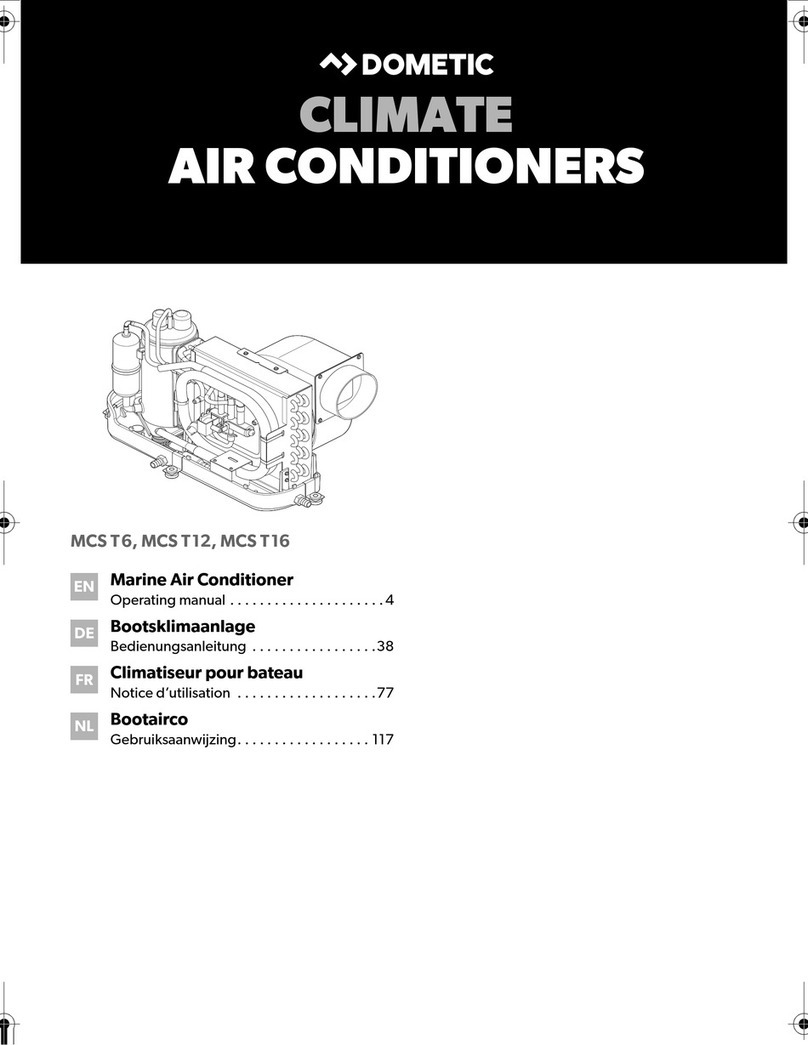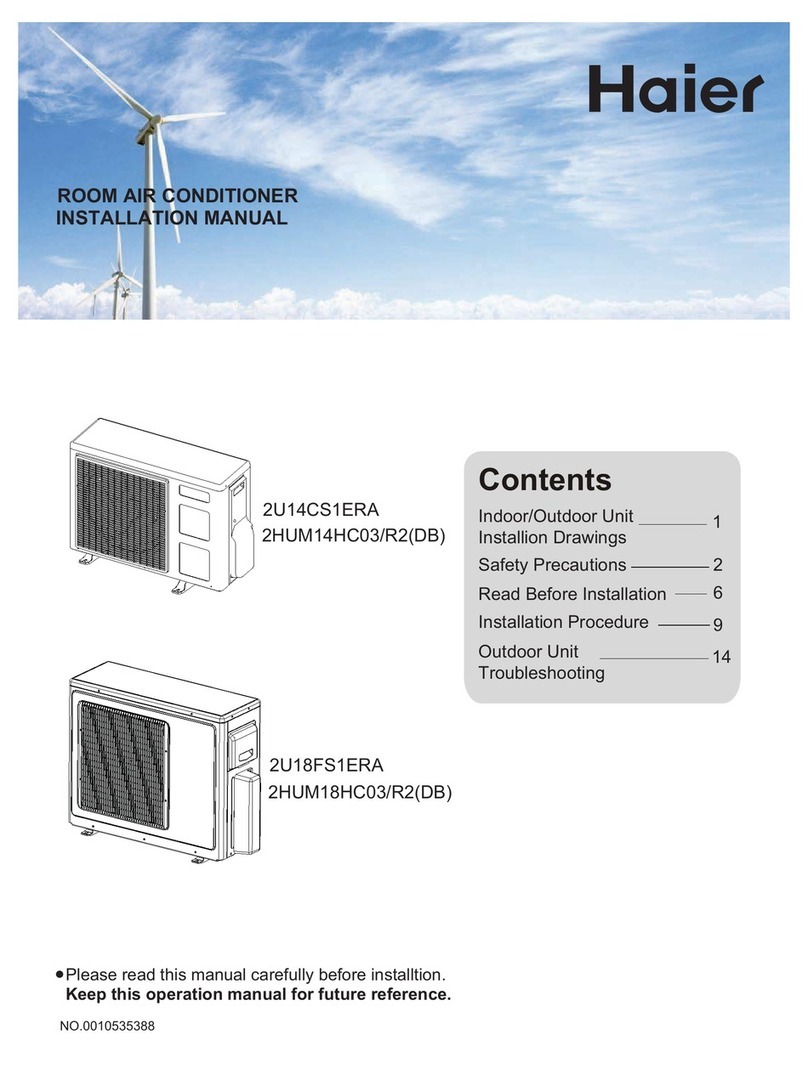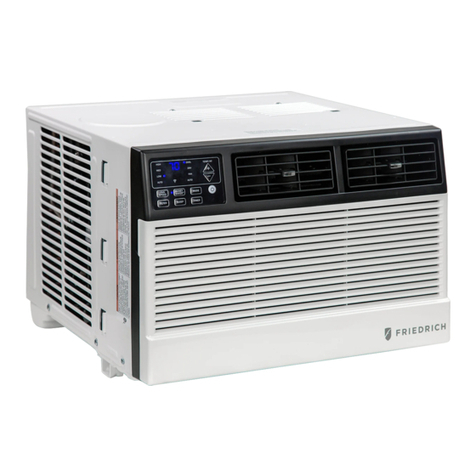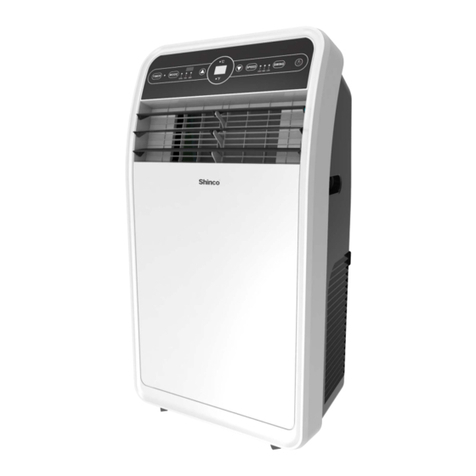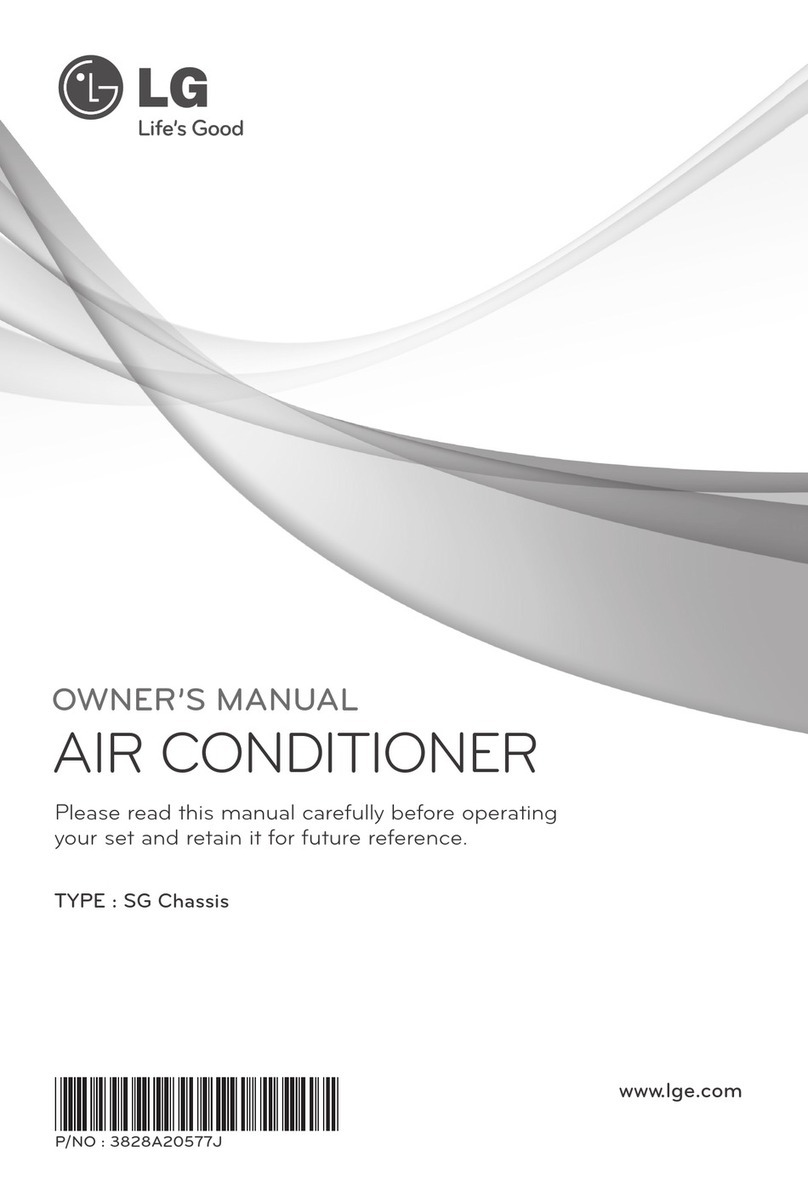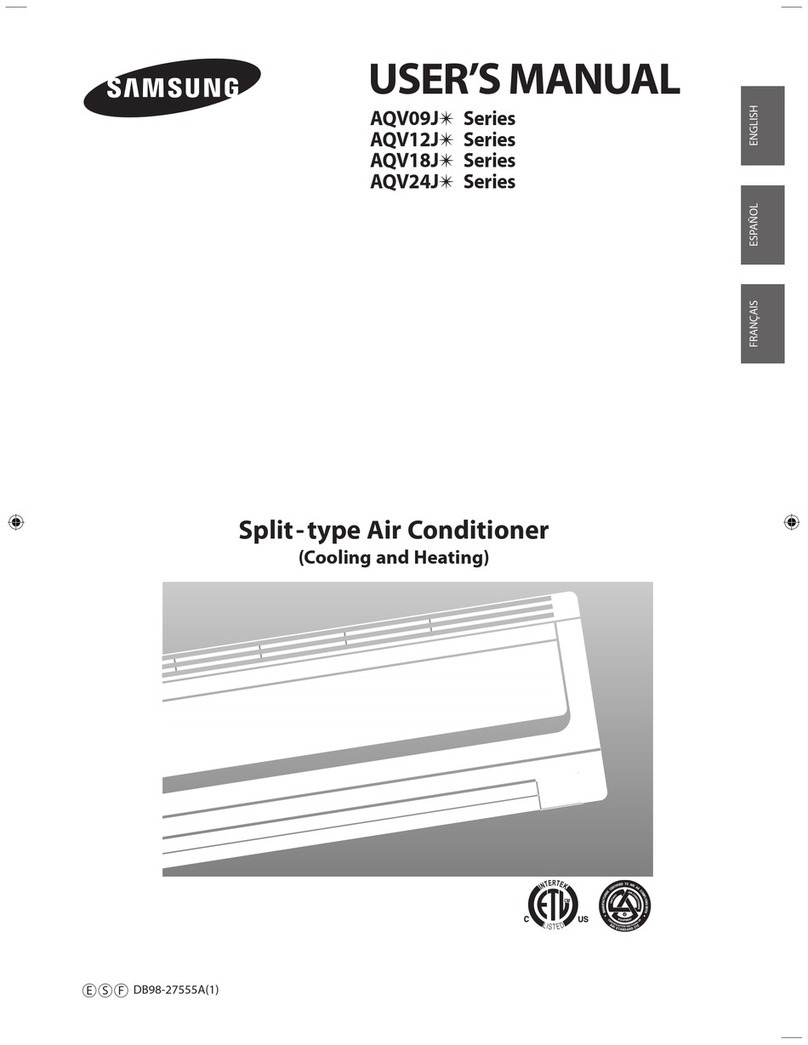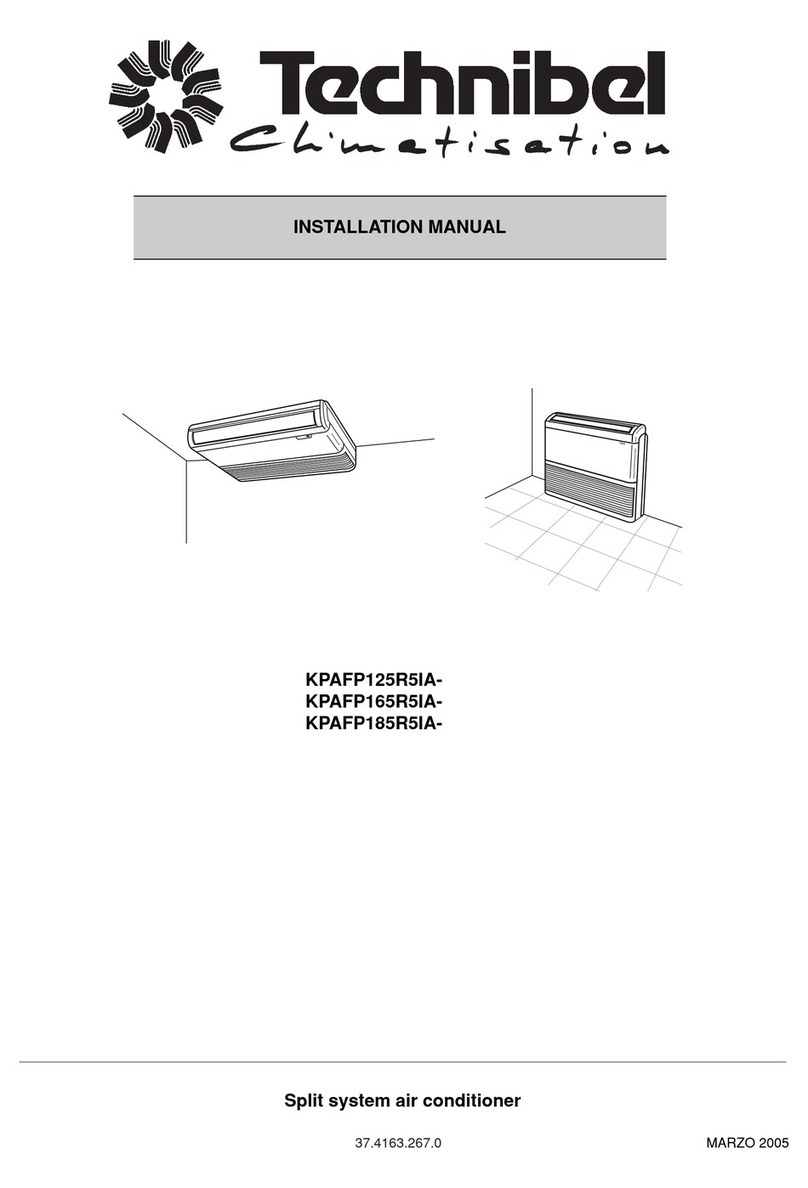ClimateMaster GT-S Guide

INSTALLED BY:
Geothermal Outdoor
Split System
Installation, Operation &
Maintenance Instructions
Revision: 5/03/02
GT-S
GT-S

Page 2
TABLE OF CONTENTS
Table of Contents 2
Model Nomenclature 3
Storage 3
Pre-Installation 3
Physical Data 4
Physical Dimensions 4
Equipment Selection 5
Split System Coil Application Guide 5
Unit Installation 6
Ground Coupled Connection 7
Antifreeze 8
Open Loop/Well Water Installation 9
Refrigeration Installation 10
Evacuation and Charging 12
Hot Water Generator 14
Electrical Data 15
Line Voltage Field Wiring 15
Low Voltage Field Wiring 16
Water Valve Wiring 16
Freeze Protection Selection 16
Electrical Wiring Schematic 17
CXM Module Description 18
Control/Unit Troubleshooting 21
Operating Limits 25
Unit Start-Up Procedure 25
Pressure Drop Table 27
Operating Pressures 27
Preventive Maintenance 28

Page 3
38 WQ-S 018 SS C3
Prefix
Series
S = Split
Size
18,24,30,36,42,48, or 60
Standard
01
Packing
Rev. Code
Power
3 = 230/1PH/60HZ
Condenser
C = Copper
D = CU w/HWG
N= Cupro-Nickel(CN)
P = CN w/HWG
GENERAL INFORMATION
Inspection
Upon receipt of the equipment, carefully check the
shipment against the bill of lading. Make sure all units
have been received. Inspect the carton or crating of each
unit, and inspect each unit for damage. Assure the carrier
makes proper notation of any shortages or damage on all
copies of the freight bill and he completes a common
carrier inspection report. Concealed damage not
discovered during unloading must be reported to the
carrier within 15 days of receipt of shipment. If not filed
within 15 days, the freight company can deny the claim
without recourse. NOTE: It is the responsibility of the
purchaser to file all necessary claims with the carrier.
Notify the Traffic Department of all damage within
fifteen (15) days of shipment.
Storage
Equipment should be stored in its shipping carton in a
clean, dry area. Store units in an upright position at all
times. Stack units a maximum of 3 units high. DO NOT
remove equipment from shipping cartons until
equipment is required for installation.
Unit Protection
Cover units on the job site with either shipping cartons,
vinyl film, or an equivalent protective covering. Cap the
open ends of pipes stored on the job site. In areas where
painting, plastering, spraying is not been completed, all
due precautions must be taken to avoid physical damage
to the units and contamination by foreign material.
Physical damage and contamination may prevent proper
start-up and may result in costly equipment clean-up.
Examine all pipes, fittings, and valves before installing
any of the system components. Remove any dirt or trash
found in or on these components.
Pre-Installation
Installation, operation and maintenance instructions are
provided with each unit. Before unit start-up, read all
manuals and become familiar with the unit and its
operation. Thoroughly check the system before
operation.
Prepare units for installation as follows:
1. Compare the electrical data on the unit nameplate
with ordering and shipping information to verify the
correct unit has been shipped.
2. Keep the cabinet covered with the shipping carton
until installation is complete and all plastering,
painting, etc., is finished.
3. Verify refrigerant tubing is free of kinks or dents and
that it does not touch other unit components.
4. Inspect all electrical connections. Connections must
be clean and tight at the terminals.
MODEL NOMENCLATURE

Page 4
To avoid equipment damage, DO NOT use these
units as a source of heating or cooling during
the construction process. The mechanical
components and filters used in these units will
quickly become clogged with construction dirt
and debris which may cause system damage.
To avoid the release of refrigerant into the
atmosphere, the refrigerant circuit of this unit
must be serviced only by technicians who meet
local, state and federal proficiency
requirements.
All refrigerant discharged from this unit must
be recovered WITHOUT EXCEPTION.
Technicians must follow industry accepted
guidelines and all local, state and federal
statutes for the recovery and disposal of
refrigerants.
If a compressor is removed from this unit,
system refrigerant circuit oil will remain in the
compressor. To avoid leakage of compressor oil,
the refrigerant lines of the compressor must be
sealed after it is removed.
Table 1 - GT-S Physical Data
GT-S Dimensions
33
22
26
MODEL 1 8 2 4 3 0 3 6 4 2 4 8 6 0
Compressor Rotary
Factory Charge R22 - (oz.) 70 74 85 101 122 130 na
Water Connection Size (fpt swivel) 1-1/4" MPT (for Flow Controller)
Suction Line Sweat Connection (in.) 3/4" 3/4" 7/8" 7/8" 7/8" 7/8" 1-1/8"
Liquid Line Sweat Connection (in.) 3/8" 3/8" 3/8" 3/8" 3/8" 3/8" 1/2"
Weight - Operating na na na na na na na
Weight - Packaged na na na na na na na
All units have grommet compressor mounting, TXV expansion devices, 20 ga sheet metal, weather resistant cabinet,
and 7/8" & 7/8" & 1-1/8" electrical knockouts.
Hot Water Generator ready with factory installed hot gas service ports
Scroll

Page 5
The installation of Geothermal Heat Pump units and all
associated components, parts and accessories which
make up the installation shall be in accordance with the
regulations of ALL authorities having jurisdiction and
MUST conform to all applicable codes. It is the
responsibility of the installing contractor to determine
and comply with ALL applicable codes and regulations.
General
Call your distributor for appropriate combinations of GT-
S Split condensing units, air handlers, and coils.
Utilizing the Existing Air Handler or Coil
It is recommended that a new coil or airhandler be
installed with the GT-S due to the low initial cost of the
additional equipment versus the reliability and benefit of
new warranty etc. However, the existing air handler may
be retained and used provided the following:
•Coil currently uses an orifice or TXV. The orifice
should be removed and a TXV installed according to the
procedure outlined here. If the coil utilizes capillary
tubes as the expansion system it will not operate properly
with the GT-S system and the coil should be replaced
with a new one.
• The coil should match Table 2 and 3 for square footage,
number of circuits and fin spacing.
• Life expectancy of more than 7 years left in the
components such as fan motors, coil and cabinet.
EQUIPMENT SELECTION
Split System Coil Application Guide
The 50YCS (GT-G)/38WQS (GTR-S) series units have been tested in accordance with
ARI standard 330. Unit performance has been certified with a specific air handler/air
coil. The following is a guideline designed to assist the system designer with matching
these units with air handlers and air coils.
To match these units to an Air Handler/A-coil you will need to base the coil selection
using the following conditions:
ARI
Standard 330-93 DB deg. F WB deg. F EWT deg. F
Cooling 80 67 77
Heating 70 60 32
Note: Design GPM flow rate = 3 gpm/ton
The following table gives the required capacity the Air Handler/A-coil must yield at the
above conditions and the tabulated CFM and Evaporator temperature. Interpolation
maybe required by the designer.
Guidelines for matching coils to Genesis split and Paradigm Units
CFM Evaporator Deg. F MBTU Capacity
Carrier Unit
50YCS/38WQS
600 50 18.5 - 21.3 018
800 47 25.5 - 29.3 024
1000 49 31.5 - 36.2 030
1200 48 37.0 - 42.5 036
1400 45 42.2 - 48.5 042
1600 46 50.0 - 57.5 048
1800 45 58.0 - 66.7 060
Note(s): Split units are designed for use with 12 SEER or higher rated Heat Pump
Air Handlers/A-coils.
Indoor matching Adjustable TXV's should be used with any Air
Handler/A-coil - See Residential Price & Product Catalog P/N CA166
All Air Handler/A-coil selections MUST use TXV, fixed meter devices are not
acceptable. - See GTR-S/GT-G Split Accessories Page in Catalog P/N CA166
If you are unsure of your selection, you may forward Air Handler/A-coil performance
Model data as provided by the manufacture to your Carrier Distributor/ClimateMaster
Factory Technical Support /Engineering department for assistance. Guidelines subject to
change without notice.

Page 6
Removing Existing Condensing Unit
1. To pump down condensing unit. Close the liquid line
service valve of existing condensing unit and start
compressor to pump refrigerant back into compres-
sor section. Then close suction service valve while
compressor is still running to trap refrigerant in
outdoor section. Immediately kill power to the
condensing unit.
2. Remove old condensing unit. Disconnect power and
low voltage. Cut or unbraze line set from unit.
Remove condensing unit.
3. If condensing unit is not operational or will not
pump down, refrigerant should be recovered using
appropriate equipment.
Air Handler Installation
Although the air handler section of this manual does not
contain a comprehensive installation instruction it does
provide many useful diagrams and tables specific to the
GT-S and Air Handler combined system. The airhandler
mounting should be installed according to the instruc-
tions provided with the air handler itself.
GT-S Location
Locate the unit in an outdoor area that allows easy loop
and lineset access and also has enough space for service
personnel to perform typical maintenance or repairs. GT-
S units are usually installed on a condensor pad directly
outside the lineset access into the building. The service
valve side can be located toward the building keeping the
loop access end away from the building. Conform to the
following guidelines when selecting unit location:
1. Provide adequate access for loop trench excavation.
2. Locate directly outside lineset penetration as
possible. Utilize existing condensor pad where
possible.
3. Provide access for servicing and maintenance.
GT-S Mounting
GT-S unit may be mounted on an ASP2436P air pad with
loop access hole as shown in Figure 1. When mounting
on an existing concrete condenser pad 3" holes can be
bored through to accomodate the pipe (1-1/4") and 1/2"
insulation. Figure 2 illustrates the dimensions of the
holes required.
Figure 1. GT-S unit mounting
Figure 2. Existing Pad Hole Dimensions
INSTALLATION
Air Pad with
access hole
Existing Pad larger than 22 x 33
Bottom view of
Paradigm Unit
22x33
Flow
Controller 8.00"
25"
Drill 3” holes for clearance of
1-1/4” pipe with 1/2” wall
insulation
5.5 “ 8.25”

Page 7
Figure 3. Flow Controller Mounting
Internal FC1 Flow Controller Mounting
The Flow Controller can be mounted in the GT-S unit
directly inside the cabinet as shown in Figure 3. Studs are
provided with which to mount the flow controller.
Carefully mate the water lines from the GT-S unit into
the flow controller swivel connections. The GT-S water
connections are 1-1/4" Male Pipe Thread (MPT)
designed to mate with swivel piping fittings of the FC1
flow controller. NOTE THE FC2 UTILIZES 1" FPT.
The swivel connector has a rubber gasket seal similar to a
garden hose gasket, which when mated to the flush end
of any 1-1/4" threaded pipe provides a leak-free seal
without the need for thread sealing tape or compound.
Check to insure that the rubber seal is in the swivel
connector prior to attempting any connection. (The
rubber seals are shipped attached to the swivel
connector.) If the fitting does not fit over the brass swivel
fitting, emory cloth can be used to knock the edge off of
the Flow Controller internal swivel fitting. DO NOT
OVERTIGHTEN or leaks may occur. Figure 3 also
shows the installation of an AFCS1 adaptor kit for
use with the GT-S to extend the non-pump connection
up to the GT-S water connections
Figure 4. The Female Locking Ring is threaded onto
the pipe threads which holds the male pipe end
against the gasket, and seals the joint. HAND
TIGHTEN ONLY! DO NOT OVERTIGHTEN!
Connecting the Earth Loop To FC1
NOTE THE FC2 UTILIZES 1" FPT. The earth loop
trench should be continued directly under the GT-S unit
as shown in Figure 5. When connecting the earth loop to
the GT-S unit, care should be taken to measure the
supply return piping before cutting and adding the fitting
for connection to the flow controller. Allow movement
of the pipe for fusion and/or connection up into the flow
controller. Prevent the pipe from exerting stress on the
fitting and insure proper backfill to support the pipe
during any trench settling. The pipe can be bent to relive
any pressure on the fitting.
Any standard 1-1/4" MPT should fit the swivel fittings of
the flow controller. Some PE to Flow Controller
connection options are:
• GMA6INS 1-1/4" mpt x 1-1/4" barb
• GFMC66S 1-1/4" mpt (swivel) x 1-1/4" barb
• GFMA66 1-1/4" mpt x 1-1/4" PE fusion
All 1-1/4" piping should be completely and continu-
ously insulated with a minimum 1/2" x 1-5/8" ID
closed cell insulation from below the ground surface
to the flow controller (1-1/4" ID for 1" IPS PE).
Flush and Filling of the Earth Loop
Once piping is completed between the unit, flow center
and the ground loop, final purging and charging of the
loop is needed. A flush cart (at least a 1.5 hp pump) is
needed to achieve adequate flow velocity in the loop to
purge air and dirt particles from the loop itself. All air
and debris must be removed from the earth loop piping
system before operation. Flush the loop with a high
volume of water at a high velocity (2 fps in all piping),
both directions. The steps below must be followed for
proper flushing and are presented in more detail in the
Flow Controller Installation Manual.
Figure 4. Swivel Connections
Gasket
Swivel Nut
Stainless steel
snap ring
Brass Adaptor
Hand Tighten
Only!
Do Not
Overtighten!

Page 8
Fill loop with water from a garden hose through flush
cart before using flush cart pump to ensure an even fill.
Once full, do not allow the water level in the flush cart
tank to drop below the pump inlet line or air can be
pumped back out to the earth loop. Maintain a fluid level
in the tank above the return tee so that air can not be
continuously mixed back into the fluid. 50 psi surges can
be used to help purge air pockets by simply shutting off
the return valve going into the flush cart reservoir. This
‘dead heads’ the pump to 50 psi To dead head the pump
until maximum pumping pressure is reached, open the
valve back up and a pressure surge will be sent through
the loop to help purge air pockets from the piping
system. Notice the drop in fluid level in the flush cart
tank. If air is purged from the system, the level will
drop only 1-2 inches in a 10" diameter PVC flush
tank (about a half gallon) since liquids are
incompressible. If the level drops more than this,
flushing should continue since air is still being
compressed in the loop fluid. Do this a number of times.
When the fluid level is dropping less than 1-2" in a 10"
diameter tank the flow can be reversed. Finally the dead
head test should be checked again for an indication of air
in the loop. This fluid level drop is your only
indication of air in the loop. Antifreeze may be added
before, during or after the flushing procedure. However,
depending upon which time is chosen, antifreeze could
be wasted when emptying the flush cart tank. Loop static
pressure will fluctuate with the seasons. Pressures will be
higher in the winter months than during the cooling
season. This fluctuation is normal and should be
considered when charging the system initially. Pressurize
the loop to a static pressure of 40-50 psi (winter) 15-20
psi (summer).
After pressurization, be sure to remove the plug in the
end of the Grundfos loop pump motor(s) to allow trapped
air to be discharged and to insure the motor housing has
been flooded. This is not required for Taco circulators.
Insure the loop flow center provides adequate flow
through the unit by checking pressure drop across the
heat exchanger and comparing it to the figures shown in
Table 13.
ANTIFREEZE - In areas where minimum entering loop
temperatures drop below 40°F or where piping will be
routed through areas subject to freezing, anti-freeze is
needed. Alcohols and glycols are commonly used as
antifreezes, however your local territory manager should
be consulted for the antifreeze best suited to your area.
Freeze protection should be maintained to 15°F below
the lowest expected entering loop temperature. If unit is
located outdoors freeze protection should be
maintained to 25°F below the lowest expected
entering loop temperature. Consult the Flow Controller
Installation Manual for further details.
FREEZE PROTECTION - When an antifreeze is
selected the freeze protection setpoint should be switched
to the lower setting to avoid nuisance faults. Consult
'freeze protection' in the controls section for more
information.
Figure 5. Typical Earth Loop Connection
Paradigm
Condensing
Unit
Air Pad with
access hole
Header Pit
Backfill carefully to avoid
stress on piping and flow
controller connection
P/T Ports
Insulate all piping with 1/2”
closed cell insulation
Flow Controller

Page 9
ALTHOUGH THE GT-S IS COMPATIBLE WITH
OPEN LOOP APPLICATIONS, IT HAS BEEN
DESIGNED FOR OUTDOOR EARTH LOOP
APPLICATIONS. THE GT-G INDOOR SPLIT
WOULD BE A BETTER CHOICE FOR THIS INDOOR
APPLICATION.
Open loop applications should always be located in a
conditioned space that will prevent freezing pipes.
Typical open loop piping is shown in Figure 6. Shut off
valves should be included in case of servicing. Boiler
drains or other valves should be ‘tee’d’ in the line to
allow acid flushing of just the heat exchanger. Pressure
temperature plugs should be used so that flow and
temperature can be measured. The water freezestat
should be wired. Piping materials should be limited to
PVC SCH80 or copper. Due to the pressure and
temperature extremes, PVC SCH40 is not
recommended.
Water Quantity should be plentiful and of good quality.
Consult CM for water quality guidelines. The unit can be
ordered with either a copper or cupro-nickel water heat
exchanger. Copper is recommended for closed loop
systems and open loop ground water systems that are not
high in mineral content or corrosiveness. In conditions
anticipating heavy scale formation or in brackish water, a
cupro-nickel heat exchanger is recommended. In ground
water situations where scaling could be heavy or where
biological growth such as iron bacteria will be present, a
closed loop system is recommended. Heat exchanger
coils may over time lose heat exchange capabilities due
to a build up of mineral deposits inside. These can be
cleaned only by a qualified service mechanic as acid and
special pumping equipment are required. Desuperheater
coils can likewise become scaled and possibly plugged.
In areas with extremely hard water, the homeowner
should be informed that the heat exchanger may
require occasional acid flushing.
Expansion Tank and Pump
Use a closed, bladder-type expansion tank to minimize
mineral formation due to air exposure. The expansion
tank should be sized to handle at least one minute run
time of the pump to prevent premature pump failure
using its drawdown capacity rating. The pump should be
sized to the home’s domestic water load (5-9 gpm) plus
the heat pump water load. Discharge water from the unit
is not contaminated in any manner and can be disposed
of in various ways, depending on local building codes,
i.e. recharge well, storm sewer, drain field, adjacent
stream or pond, etc. Most local codes forbid the use of
sanitary sewer for disposal. Consult your local building
and zoning department to assure compliance in your area.
Water Control Valve
Note the placement of the water control valve. Always
maintain water pressure in the heat exchanger by placing
water control valves at the outlet of the unit to prevent
mineral precipitation. Pilot operated or Taco slow closing
valve’s solenoid valves are recommended to reduce water
hammer. If water hammer persists, a mini-expansion tank
can be mounted on the piping to help absorb the excess
hammer shock. Insure that the total ‘VA’ draw of the
valve can be supplied by the unit transformer. For
instance the Taco slow closing valve can draw up to
35VA. This can overload smaller 40 or 50 VA
transformers depending on the other controls employed.
A typical pilot operated solenoid valve draws
approximately 15VA. Note the special wiring diagram of
the AVM valve Figure 17.
Flow Regulation
Flow regulation can be accomplished by two methods.
Most water control valves have a flow adjustment built
in. By measuring the pressure drop through the unit heat
exchanger flow rate can be determined and compared to
Table 13. Since the pressure is constantly varying two
pressure gauges might be needed. Simply adjust the
water control valve until the desired flow of 1.5 to 2 gpm
per ton is achieved. Secondly a flow control device may
be installed. The devices are typically an orifice of plastic
material that are designed to allow a specified flow rate.
these are mounted on the outlet of the water control
valve. On occasion these valves can produce a velocity
noise that can be reduced by applying some back
pressure. This is accomplished by slightly closing the
leaving isolation valve of the well water setup.
Freeze Protection
The high temperature freeze protection setpoint (water)
should be activated to avoid freeze damage to the unit.
Consult the freeze protection section of the controls
description for instructions.
OPEN LOOP - GROUND WATER SYSTEMS
Figure 6. Typical Well Installation Detail
Pressure Ports
Pilot Operated or
Slow Closing Valve
Flow Regulator
Isolation Valves
Flush Ports
Paradigm Unit
1-1/4” FPT
From Domestic
Supply
To Disposal

Page 10
Line Set Installation
Figure 9 and 10 show typical installations with an
airhandler and an add-on furnace coil respectively. Table
5 shows typical line-set diameters at various lengths.
Lineset lengths should be kept to a minimum and should
always be installed with care to avoid kinking. Line sets
over 60 feet long are not recommended on the GT-S
Table 5. Lineset Diameters and Charge Information
REFRIGERATION INSTALLATION
Figure 7. Attaching the Air Coil
because of oil transport problems and excessive
refrigerant pressure drop. If the line set is kinked or
distorted, and it cannot be formed back into it’s original
shape, the bad portion of the pipe should be replaced. A
restricted line set will effect the performance of the
system. A reversible heat pump filter drier is installed on
the liquid line inside the GT-S cabinet. All brazing
should be performed using a nitrogen circulating at 2-
3psi to prevent oxidation inside the tubing. All
linesets should be insulated with a minimum of 1/2"
thick closed cell insulation. All insulation tubing
should be sealed using a UV resistant paint or
covering to prevent deterioration from sunlight.
Installing the Coil
Figure 7 shows the installation of the lineset and txv to a
typical coil. The coil and TXV are ordered separately
from the air handler (refer to Table 2 for selection).
Fasten the copper line set to the coil. Nitrogen is to be
bled through the system at 2-3 psi to prevent oxidation
inside the refrigerant tubing. Use a low silver phos-
copper braze alloy on all brazed connections.
Add-On GT-S Applications
In Add-on GT-S applications the coil should be located
in the supply side of the furnace to avoid condensation
damage to the furnace heat exchanger. Also a high
temperature limit switch should be installed as shown in
Figure 10 just upstream of the coil to de-energize the
compressor any time the furnace is energized (and thus
blowing hot air directly into the coil and elevating
refrigerant temperatures during operation). Without this
switch the GT-S will trip out on high pressure lockout.
Figure 8. GT-S Unit Connection and Service Valve
Position Table
Position Description System Service
Port
CCW - Full Out Operation Position Open Closed
CCW - Full Out 1/2 turn CW Service Position Open Open
CW - Full In Shipping Position Closed Open
TXV (‘IN’ toward outdoor
condensing unit)
Suction Line
Liquid Line
Bulb
Equalizer
Line
TXV has internal
check valve
Braze
connection
Service ports for
attaching refrigeran
t
gauges
Replace caps
after adjusting
service valves
Paradigm Factory† Basic* 20 feet 40 feet 60 feet
Model Charge (oz) Charge (oz) Liquid Suction Liquid Suction Liquid Suction
P18 70 55 3/8" 3/4" 3/8" 3/4" 3/8" 3/4"
P24 74 59 3/8" 3/4" 3/8" 3/4" 3/8" 7/8"
P30 86 71 3/8" 3/4" 3/8" 7/8" 3/8" 7/8"
P36 101 86 3/8" 3/4" 3/8" 7/8" 3/8" 7/8"
P42 122 107 3/8" 7/8" 3/8" 7/8" 3/8" 7/8"
P48 130 115 3/8" 7/8" 3/8" 7/8" 1/2" 1-1/8"
P60 136 106 3/8" 1-1/8" 1/2" 1-1/8" 1/2" 1-1/8"
*Basic charge includes only the amount required for the condensing unit and the evaporating coil.
An additional amount should be added allowing 0.6 oz for 3/8" and 1.2 oz for 1/2" per foot of
lineset used.
†
Factory charge is preset for 25' lineset

Page 11
Figure 9. Typical GT-S/ Air Handler Installation
Figure 10. Typical GT-S/Add-on Coil Installation
Insulated line
set with UV
Paint
Power
Disconnects
PVC Condensate
with vented trap
Air Pad
Low Voltage Wiring
Return Plenum
Condensing
Unit
Air Handler
TXV ‘IN’ toward
outdoor
condensing Unit
Insulated line
set with UV
Paint
Power
Disconnects
PVC Condensate
with vented trap
Air Pad
Low Voltage Wiring
Return Plenum
Condensing Unit
Fossil Furnace
Add-On
‘A’ Coil
Air
Temperature
Limit Switch
TXV ‘IN’ toward outdoor
condensing unit

Page 12
Note: The air coil should be thoroughly washed with a
filming agent, (dishwasher detergent, Cascade). To help
condensate drainage. Apply a 20 to 1 solution of Cascade
and water, spray both sides of coil. Repeat and rinse
thoroughly with water.
The TXV can be braze into place as shown keeping the
'IN' side toward the outdoor GT-S unit. The TXV has an
internal check valve and must be installed in the proper
direction for operation. Always keep the valve body cool
during brazing to prevent damage to the TXV. When
attaching the equalizer flare always lubricate with a small
amount of refrigerant oil to prevent leaks. Attach the bulb
to the suction line using the supplied hose clamp. Be
careful not to overtighten the clamp and deform the
bulb.
Installing the Lineset to GT-S Unit
Braze line set to the service valve stubs on the front of
the GT-S cabinet as shown in Figure 8. On installations
with long line sets, copper adapters may be needed to
connect the larger diameter tube to the stubs. Nitrogen is
to be bled through the system at 2 - 3 psi to prevent
oxidation contamination. Use a low silver phon-copper
braze alloy on all brazed connections. GT-S cabinets are
shipped with a factory charge and service valves are not
to be opened until the line set has been leak tested,
purged and evacuated. See Charging the System.
Evacuation and Charging the Unit
LEAK TESTING- The refrigeration line set must be
pressurized and checked for leaks before purging and
charging the unit. To pressurize the line set, attach
refrigerant gauges to the service ports and add refrigerant
R-22 or an inert gas (nitrogen or dry carbon dioxide)
until pressure reaches 60 - 90 psig. Never use oxygen or
acetylene to pressure test. Use a halogen leak tester or a
good quality bubble solution to detect leaks on all
connections made in the field. Check the service valve
ports and stem for leaks. If a leak is found repair it and
repeat the above steps. For safety reasons do not
pressurize system above 150 psig. System is now ready
for processing and charging.
EVACUATION OF THE LINESET AND COIL- The
line set and coil must be evacuated to at least 200
microns to remove any moisture and noncondensables.
Evacuate the system through both service ports in the
shipping position (full CW in) to prevent false readings
on the gauge because of pressure drop through service
ports. The system is now ready for charging.
CHARGING THE GT-S SYSTEM - There are two
methods of charging a refrigerant system. One method is
the total charge method, where the volume of the system
is determined and the refrigerant is measured and added
into the evacuated system. The other method is the partial
charge method where a small initial charge is added to an
evacuated system, and remaining refrigerant added
during operation.
TOTAL CHARGE METHOD - See Table 2 for the basic
charge of GT-S units. For line sets with 3/8'’ liquid lines
add 0.6 ounces of refrigerant to the basic charge for
every installed foot of liquid line. Add 1.2 oz. per foot if
using l/2'’ line. Once the total charge is determined, the
factory pre-charge (Table 2) is subtracted and the
remainder is the amount needed to be added to the
system. This method should only be used when using the
ARI matched air handler.
EXAMPLE: Model GT-S P48 with 40 feet of installed
liquid line (3/8” O.D.). The basic charge of GT-S P48 is
115 oz.. plus 29oz. of liquid line x 0.58 oz. per ft. =115 +
24 =139 oz. (Total Charge). The GT-S is shipped from
the factory with 130 oz. of refrigerant (for 25ft lineset),so
the amount you would add is 139 - 130 = 9 oz.
Turn service valves full out CCW and then turn back in
1/2 turn to open service ports. Add the required
refrigerant so that the total charge calculated for the unit
and line set is now in the system. Open the service valve
fully counterclockwise so that the stem will backseat and
prevent leakage through the schrader port while it is not
in use. Start unit in the heating mode and measure
Heating Cooling
EWT (°F)
SuperHeat
SubCooling
(using LL
Pressure)
SubCooling (using
Discharge
Pressure)
SuperHeat
SubCooling
(using LL
Pressure)
SubCooling
(using Discharge
Pressure)
30 5-10 5-9 8-12 12-18 12-22 15-25
50 9-12 5-9 8-12 10-15 9-16 12-18
70 10-14 3-7 6-10 10-15 7-12 10-15
90 -- -8-12 7-12 10-15
110 -- -8-10 7-11 10-14
These numbers are
g
uidlines for char
g
in
g
onl
y
and differences of 3 de
g
or less are acce
p
table
Table 6. GT-S Charging Values

Page 13
superheat and subcooling values after 5 minutes of run
time. See Table 6 for example of measuring superheat
and sub-cooling performance values. Superheat is to be
measured using suction temperature and pressure at the
compressor. Subcooling should be measured using the
liquid line temperature immediately outside the GT-S
cabinet and either the liquid line service valve pressure or
the compressor discharge pressure. Note that different
values of Table 6 will be obtained due to the pressure
losses through the condenser heat exchanger. Adding
refrigerant will increase sub-cooling while superheat
should remain fairly constant allowing for a slight
amount of hunting in TXV systems. This increase in
subcooling will require 5 minutes or so of operation
before it will be measured. After values are measured
compare to the chart and go to FINAL EVALUATION.
PARTIAL CHARGE METHOD - Open service valve
fully counterclockwise and then turn back in 1/2 turn to
open service port. Add vaporized R-22 (Gas) into the
suction side of the compressor until the pressure in the
system reaches approximately 60-70 psig. Never add
liquid refrigerant into the suction side of a compressor.
Start the unit in heating and add gas to the suction port at
a rate not to exceed five pounds per minute. Keep adding
refrigerant until the complete charge has been entered.
Superheat is to be measured using suction temperature
and pressure at the compressor. Subcooling should be
measured using the liquid line temperature immediately
outside the GT-S cabinet and either the liquid line service
valve pressure or the compressor discharge pressure.
Note that different values of Table 6 will be obtained due
to the pressure losses through the condenser heat
exchanger. Compare superheat and subcooling to the
values in Table 3. Adding refrigerant will increase sub-
cooling while superheat should remain fairly constant
allowing for a slight amount of hunting in TXV systems.
This increase in subcooling will require 5 minutes or so
of operation before it will be measured. Proceed to
FINAL EVALUATION.
FINAL EVALUATION -In a split system, cooling sub-
cooling values can be misleading depending on the
location of the measurement. Therefore it is
recommended that charging be monitored in the heating
mode. Charge should be evaluated by monitoring the
subcooling in the heating mode. After initial check of
heating sub-cooling, shut off unit and allow to sit 3-5
minutes until pressures equalize. Restart unit in the
cooling mode and check the cooling superheat against
Table 6. If unit runs satisfactorily then charging is
complete. If unit does not perform to specifications the
cooling txv (air coil side) may need to be readjusted until
the cooling superheat values are met.
To Check SuperHeat and SubCooling
Determining Superheat:
1. Measure the temperature of the suction line at a
point near the expansion valve bulb
2. Determine the suction pressure in the suction line by
attaching refrigeration gauges to the schrader
connection on the side of the compressor.
3. Convert the pressure obtained in Step 2 above to the
boiling point (sat temp) temperature by using the R-
22 Press/Temp conversion table on the gauge set.
4. Subtract the temperature obtained in Step 3 from
Step 1. The difference will be the superheat of the
unit or the total number of degrees above the boiling
point. Refer to the superheat Table 3 for superheat
ranges at specific entering water conditions.
Example:
The temperature of the suction line at the sensing bulb is
read at 50
°
F. The suction pressure at compressor is 65
psig which is the equivalent to 38
°
F saturation
temperature from R-22 Press/Temp conversion table on
the gauge set.
38°F subtracted from 50°F = 12°F Superheat
Determining Sub-Cooling:
1. Measure the temperature of the liquid line on the
small refrigerant line (liquid line) just outside the
GT-S cabinet. This location will be adequate for
measurement in both modes unless a significant
temperature drop in the liquid line is anticipated.
2. Determine the condensor pressure (High Side) by
attaching refrigerant gauges to the schrader connec-
tion on the liquid line service valve. If the hot gas
discharge line of the compressor is used, refer to the
apprpriate column in Table 3.
3. Convert the pressure obtained in step 2 above to the
boiling point temperature by using the Press/Temp
conversion table on the gauge set.
4. Subtract the temperature of Step 3 from the tempera-
ture of Step l . The difference will be the sub-cooling
value for that unit (total degrees below the boiling
point). Refer to the sub-cooling Table 3 for values at
specific entering water temperatures.
Example:
The condenser pressure at the service port is 225 prig
which is equivalent to 110
°
F and is 236psig at the
compressor (113
°
F)
100
°
F subtracted from 110
°
F = 10 degrees sub-cooling
13 degrees using the compressor discharge pressure.

Page 14
The HWG (Hot Water Generator) option provides
considerable operating cost savings by utilizing excess
heat energy from the heat pump to help satisfy domestic
hot water requirements. The HWG is active throughout
the year, providing virtually free hot water when the heat
pump operates in the cooling mode or hot water at the
COP of the heat pump during operation in the heating
mode. Actual HWG water heating capacities are pro-
vided in the Add-on HWG literature.
The GT-S utilizes an add-on Hot Water Generator
module that ties into the hot gas line of the GT-S outdoor
unit. The HWG module is remotely mounted near the
water heater and includes a water to refrigerant heat
exchanger, pump and controls. Figure 13 is a typical
example of HWG water piping connections on a GT-S.
Using a concentric hot water tank connection fitting
Refrigeration Installation
Install the Add-On HWG kit using its installation
instructions. Locate the HWG as close to the water heater
as possible.
Unbraze the hot gas u-bend as shown in Figure 11. Take
care to avoid overheating components. Install the dual
1/2" lineset to the HWG. Maximum length should be 30
feet one way. Evacuate the lineset to 200 microns
through the hot gas valves inside the GT-S unit. Open the
valves up fully (CCW looking up from cap end). Check
the lineset for leaks. Pinch the bypass tubing as shown in
Figure 12 being careful not to damage the tubing. Verify
lineset tubing is completely insulated with a minimum 1/
2" thick closed cell and painted to prevent deterioration
of the insulation due to ultra violet light and weather.
Water Piping
Connect water piping as shown in Figure 13. Keep water
piping lengths at a minimum – DO NOT use a one way
length greater than 50 feet. All installations must be
made in accordance with local codes. The installer is
responsible for knowing the local requirements, and for
performing the installation accordingly.
HOT WATER GENERATOR
Figure 12. HWG Service Valve Detail
Figure 11. GT-S HWG Connection Detail
eliminates the need to tie into the hot water tank cold
water piping. Under extreme water conditions, it may be
wise to not use the HWG option since the probable cost
of frequent maintenance may offset or exceed any
savings.
Unbraze u-tube
Hot water generator service
valve assembly
(inside cabinet)
Hot Gas to Reversing Valv
e
Hot Gas from
Compressor
Field connection of Hot
Water lineset
Pinch off here after evacuating lineset
and opening valves
Open Valves CW Close valves
CCW as looking up from
underneath
Insulated line
set with UV
Paint
Add-On Hot Water Generator
with internal pump
Waste Vent
Coupling
Cold Inlet
Hot
Outlet
Water Heater
Coaxial
Fitting
Insulated lineset
enters structure
Insulated water lines
Figure 13. Typical GT-S HWG Installation

Page 15
All field installed wiring, including electrical ground,
must comply with the National Electrical Code as well as
all applicable local codes.
Refer to the unit wiring diagrams for fuse sizes and a
schematic of the field connections which must be made
by the installing (or electrical) contractor.
Consult the unit wiring diagram located on the inside of
the compressor access panel to ensure proper electrical
hookup.
All final electrical connections must be made with a
length of flexible conduit to minimize vibration and
transmission.
General Line Voltage Wiring
Be sure the available power is the same voltage and
phase as that shown on the unit serial plate. Line and low
voltage wiring must be done in accordance with local
codes or the National Electric Code, whichever is
applicable.
GT-S Power Connection
Line voltage connection is made by connecting the
incoming line voltage wires to the “L” side of the
contactor as shown in Figure 14. Consult Table 7 for
correct wire and fuse size.
External Loop Power Connection
If the unit is to be used with an external loop pump, the
pump(s) will be connected to the loop pump wires in the
flow controller compartment as shown in Figure 3. The
pumps will automatically be cycled as required by the
unit.
To avoid possible injury or death due to electri-
cal shock, open the power supply disconnect
switch and secure it in an open position during
installation.
CAUTION: Use only copper conductors for
field installed electrical wiring. Unit terminals
are not designed to accept other types of con-
ductors.
ELECTRICAL - LINE VOLTAGE
Table 7 GT-S Electrical Data.
Figure 14. GT-S Line Voltage Field Wiring.
FCR
CRR
CCM PCB
HPS
LPS
YXC
T
Note: See FC Mounting for Flow Controller Wiring
Consult Electrical Table for wire and fuse size.
All power wiring per local code
C
A
L
R
O
Y
CRC
Grnd
L2 L1
T2 T1
CC
Rated Voltage Compressor Ext Total Min Max Supply
Model Voltage Min/Max Pump Unit Circ Fuse/ Wire
MCC RLA LRA FLA FLA Amp HACR Min AWG Max Ft
018 208-230/60/1 197/254 11.0 7.1 39.0 4.0 11.1 12.9 20 12 90
024 208-230/60/1 197/254 16.0 10.3 56.0 4.0 14.3 16.8 25 10 120
030 208-230/60/1 197/254 19.0 12.2 67.0 4.0 16.2 19.2 30 10 100
036 208-230/60/1 197/254 21.0 13.5 73.0 4.0 17.5 20.8 30 10 100
042 208-230/60/1 197/254 25.8 16.5 95.0 4.0 20.5 24.7 40 8 120
048 208-230/60/1 197/254 28.6 18.3 109.0 4.0 22.3 26.9 45 8 110
060 208-230/60/1 197/254 39.0 25.0 169.0 4.0 29.0 35.2 60 6 140
HACR circuit breaker in USA only
Wire length based on one way measurement with 2% voltage drop
Wire size based on 60°C copper conductor
All fuses Class RK-5

Page 16
Comp
Relay
CCCCG
Off On
FP1 Low Temp
FP2 Low Temp
R
C
BR BRG
Test
JW3
JW2
Thermostat Connections
The thermostat should be wired directly to the CXM/
DXM board as shown in Figure 15a. Consult the
Thermostat section for specific wiring.
Water Solenoid Valves
When using solenoid valves on ground water installa-
tions. Figure 17 illustrates a typical well water control
valve wiring. A slow closing valve may be required to
prevent water hammer. When using an AVM -Taco Slow
Closing valves on GT-S Series equipment the following
schematic should be utilized. The valve takes approxi-
mately 60 seconds to open (very little water will flow
before 45 seconds) and activates the compressor only
after the valve is completely opened by closing its end
switch. Only relay or triac based electronic thermostats
should be used with the AVM valve. When wired as
shown, the valve will operate properly with the following
notations:
1-The valve will remain open during a unit lockout.
2-The valve will draw approximately 25-35 VA through
the “Y” signal of the thermostat. This can overheat the
anticipators of electromechanical thermostats.
Therefore only relay or triac based thermostats should be
used.
ELECTRICAL - LOW VOLTAGE
Figure 15a. Low Voltage Field Wiring.
Freeze Protection
The CXM/DXM control allows the field selection of
source fluid freeze protection points. The factory setting
of FP1 is set for water (30°F). In earth loop applications
jumper FP1- Antifreeze should be clipped as shown in
Figure 15b to change the setting to 10°F, a more suitable
temperature when using antifreezes in colder earth loops.
Figure 16. Accessory Wiring
Figure 17. Well Water AVM Valve Wiring
FCR
CRR
CCM PCB
HPS
LPS
YXC
T
Thermostat Connection
See Thermostat section for Wirin
g
Details
C
A
L
R
O
Y
CRC
Grnd
L2 L1
T2 T1
CC Antifreeze -
Brown
Well - Blue
Switch blue and brown freezestat wires on CCM-LPS when
using antifreeze in systems. Tape off remaining lead.
Figure 15b. Changing FP1-Freeze Protection
Setpoint
CXM PCB
Clip this FP1
jumper for anti-
freeze systems
Rev. 4/3/00 m
Accessory Connections
A terminal paralleling the compressor contactor coil have
been provided on the CXM/DXM control of the GT-S
line. "A" has been provided to control accessory devices,
such as water valves, electronic air cleaners, humidifiers,
etc. This terminal should be used only with 24 volt
signals and not line voltage signals. This signal oper-
ates with the compressor contactor. See Figure 16 or the
wiring schematic for details.
C
Genesis Series
C
Thermostat
Y
1
2
3
Y
AVM
Taco Valve
Heater Switch
CXM Control

Page 17
Paradigm 18-60 230/60/1 Wiring Diagram Part # 69828103 Rev: C 8/19/99
GT-S 18-60

Page 18
Features
• Anti-short cycle protection
• High and Low pressure cutouts
• Water Coil freeze protection
• Air Coil freeze protection
• Random Start
• Unit Performance Sentinel
• Over/Under Voltage protection
• Diagnostic LED
• Reset Lockout at unit or disconnect
• Intelligent Reset
• Condensate Overflow sensor
• Test Mode
• Electric Heat Outputs
• Accessory Water Valve Connection
•Optional LonWorks Control (see pg 8)
Field Selectable Inputs
Test Mode - Test Mode allows the service personnel to
check the operation of the control in a timely manner. By
momentarily shorting the test terminals, the CXM
control enters a 20 minute Test Mode period in which all
time delays are sped up 15 times. Upon entering Test
Mode, the Status LED will flash a code representing the
last fault. For Diagnostic ease at the thermostat, the alarm
relay will also cycle during test mode. The Alarm relay
will cycle on and off similar to the status LED to indicate
a code representing the last fault, at the thermostat. Test
mode can be exited by shorting the test terminals for 3
seconds.
Note: Code 1 indicates there is no fault in memory;
stated differently, the control has not faulted since the
last power down.
CXM CONTROL DESCRIPTION
Retry Mode - If the control is attempting a retry of a fault,
the status LED will slow flash (slow flash=one flash
every 2 seconds) to indicate the control is in process of
retrying.
NOTE: In the following field configuration options,
jumper wires should be clipped ONLY when power is
removed from the CXM control.
Water Coil Freeze Protection Limit Setting - Jumper 2
(JW2-F12 Low Temp) provides field selection of
temperature limit setting for FP1 to be 30°F or 10°F.
Not Clipped=30°F. Clipped=10°F.
Air Coil Freeze Protection Limit Setting - Jumper 3
(JW3-FP2 Low Temp) provides field selection of
temperature limit setting for FP2 to be 30°F or 10°F.
Not Clipped=30°F. Clipped=10°F.
Alarm Relay Setting - Jumper 1 (JW1-AL2 Dry) pro-
vides field selection of Alarm Relay terminal AL2 to be
jumpered to 24Vac or to be dry (no connection).
Not Clipped=AL2 connected to R. Clipped=AL2 dry
contacts (no connection).
DIP Switches
Unit Performance Sentinel Disable - Dip Switch 1
provides field selection to disable The UPS Feature
On = Enabled. Off = Disabled.
Stage 2 - Dip Switch 2 provides selection of whether
compressor has an on delay. If set to stage 2, the
compressor will have a 3 second delay before energizing.
Also, if set for stage 2, the alarm relay will NOT cycle
during test mode.
On = Stage 1 . Off = Stage 2
Table 8. LED & Alarm Relay Operations
Special Notes and Examples:
-Slow Flash = 1 flash every 2 seconds
-Fast Flash = 2 flashes every 1 second
-Flash code 2 = 2 quick flashes, 10 sec.
pause, 2 quick flashes, 10 sec. pause, etc.
Description of Operation LED Alarm Relay
Normal Mode On Open
Normal Mode with UPS Warning On Cycle (closed 5 sec., Open 25 sec.)
CXM is non-functional Off Open
Fault Retry Slow Flash Open
Lockout Fast Flash Closed
Over/Under Voltage Shutdown Slow Flash Open (Closed after 15 minutes)
Test Mode - No fault in memory Flashing Code 1 Cycling Code 1
Test Mode - HP Fault in memory Flashing Code 2 Cycling Code 2
Test Mode - LP Fault in memory Flashing Code 3 Cycling Code 3
Test Mode - FP1 Fault in memory Flashing Code 4 Cycling Code 4
Test Mode - FP2 Fault in memory Flashing Code 5 Cycling Code 5
Test Mode - CO Fault in memory Flashing Code 6 Cycling Code 6
Test Mode - Over/Under
shutdown in memory Flashing Code 7 Cycling Code 7
Test Mode - UPS in memory Flashing Code 8 Cycling Code 8

Page 19
The following safety features are provided to protect the
compressor, heat exchangers, wiring and other compo-
nents from damage caused by operation outside of design
conditions.
Anti-Short Cycle Protection- The control features a 5
minute anti-short cycle protection for the compressor.
NOTE: The 5 minute anti-short cycle also occurs at
power up.
Random Start - The control features a random start upon
power up of from 5-80 seconds.
Fault Retry - In Fault Retry mode, the Status LED
begins slow flashing to signal that the control is trying to
recover from a fault input. The CXM control will stage
off the outputs and then “try again” to satisfy the thermo-
stat "Y" input call. Once the thermostat input calls are
satisfied, the control will continue on as if no fault
occured. If 3 consecutive faults occur without satisfying
the thermostat "Y" input call, then the control will go to
Lockout mode. The last fault causing the lockout will be
stored in memory and can be viewed by going into test
mode.
Lockout - In Lockout mode, the Status LED will begin
fast flashing. The compressor relay is turned off immedi-
ately. Lockout mode can be soft reset via the thermostat
“Y” input or can be hard reset via the disconnect. The
last fault causing the lockout will be stored in memory
and can be viewed by going into test mode.
Lockout with Emergency Heat - While in Lockout
mode, if W becomes active, then Emergency Heat mode
will occur.
High Pressure Switch - When the High Pressure Switch
opens due to high refrigerant pressures, the Compressor
relay is de-energized immediately since the High
Pressure Switch is in series with the compressor
contactor coil. The High Pressure Fault recognition is
immediate as well.
High Pressure Lockout Code = 2
Example: 2 quick flashes, 10 sec pause, 2 quick flashes,
10 sec. pause, etc.
Low Pressure Switch - The Low Pressure Switch must
be open and remain open for 30 continuous seconds
during "on" cycle to be recognized as a Low Pressure
fault. If the low pressure switch is open for 30 seconds
prior to compressor power up it will be considered a low
pressure (loss of charge) fault. The Low Pressure Switch
input is bypassed for the initial 60 seconds of a compres-
sor run cycle.
Low Pressure Lockout Code = 3
Water Coil Freeze Protection (FP1) - The FP1 ther-
mistor temperature must be below the selected freeze
protection limit setting for 30 continuous seconds during
a compressor run cycle to be recognized as a FP1 fault.
The FP1 input is bypassed for the initial 60 seconds of a
compressor run cycle.
FP1 Lockout Code = 4
Air Coil Freeze Protection (FP2) - The FP2 thermistor
temperature must be below the selected freeze protection
limit setting for 30 continuous seconds during a compres-
sor run cycle to be recognized as a FP2 fault. The FP2
input is bypassed for the initial 60 seconds of a compres-
sor run cycle.
FP2 Lockout Code = 5
Condensate Overflow - The Condensate Overflow sensor
must sense overflow levels for 30 continuous seconds to
be recognized as a CO fault. Condensate Overflow will
be monitored at all times.
CO Lockout Code = 6
Over/Under Voltage Shutdown - An Over/Under
Voltage condition exists when the control voltage is
outside the range of 19Vac to 30Vac. Over/Under
Voltage Shutdown is self resetting in that if the voltage
comes back within range of 19Vac to 30Vac for at least
0.5 seconds, then normal operation is restored. This is
not considered a fault or lockout. If the CXM is in over/
under voltage shutdown for 15 minutes, the alarm relay
will close.
Over/Under Voltage Shutdown Code = 7
Unit Performance Sentinel-UPS (patent pending) - The
UPS feature warns when the heat pump is operating
inefficiently. A UPS condition (code 8) exists when:
a) in heating mode with compressor energized, if FP2 is
greater than 125°F for 30 continuous seconds, or
b) in cooling mode with compressor energized, if FP1 is
greater than 125°F for 30 continuous seconds, OR FP2 is
less than 40°F for 30 continuous seconds.
If a UPS condition occurs, the control will immediately
go to UPS warning. The status LED will remain on as if
the control is on Normal mode. (see"LED and Alarm
Relay Operation Table" ). Outputs of the control,
Safety Features

Page 20
Diagnostic Features
The Status LED on the CXM control advises the service-
man of the current status of the CXM control. The status
LED can display either the current CXM mode or the last
fault memory if in test mode. See Table 1 for a complete
listing of codes.
Unit Operation Description
PowerUp - The unit will not operate until all the inputs
and safety controls are checked for normal conditions.
NOTE: The compressor will have a 5 minute anti-short -
cycle delay at power-up.
Standby - In Standby mode, Y and W inputs are not
active. Inputs O and G may be active. Compressor will
be off.
Cooling - To enter Cooling mode, Y and O become
active. The first time after power-up that there is a call
for compressor, the compressor will follow a 5 to 80
second random start delay. There will also be a 5 min
compressor anti-short cycle protection time as well.
After the random start delay, the compressor relay is
energized. On all subsequent compressor calls, the
random start delay is omitted.
Heating Stage 1 - To enter Heating Stage 1 mode, Y
becomes active. The first time after power-up that there
is a call for compressor, the compressor will follow a 5 to
80 second random start delay. There will also be a 5 min
compressor anti-short cycle protection time as well. After
the random start delay, the compressor relay is energized.
On all subsequent compressor calls, the random start
delay is omitted.
Heating Stage 2 - To enter Heating Stage 2 mode, W
becomes active (Y already active). The Compressor relay
remains on. EH1 is turned on immediately. With
continuing Heating Stage 2 demand, EH2 will turn on
after 10 minutes. The EH2 will not turn on in heating (or
will turn off if already on) if loop temperature is above
approximately 50°F (FP1 >45°F).
Emergency Heat - In Emergency Heat mode, W be-
comes active while Y is not active. EH1 is turned on
immediately. With continuing Emergency Heat demand,
EH2 will turn on after 5 minutes. The FP1 and FP2
temperatures do not effect emergency heat operation.
excluding LED and Alarm Relay, will NOT be affected
by UPS. The UPS condition cannot occur during a
compressor off cycle. During UPS warning, the alarm
relay will cycle on and off. The cycle rate will be On for
5 seconds, Off for 25 seconds, On for 5 seconds, Off for
25 seconds, etc.
Unit Performance Sentinel Warning Code = 8
Table 9. Fault Description Table
Fault Fault LED
Code Fault Condition
No Fault In Memory 1 There has been no fault detected since the last
power down/power up sequence
High Pressure Switch 2 HP Open Instantly
Low Pressure Switch or LOC 3 LP open for 30 continuous seconds before or
during a call (bypassed for first 60 seconds)
Freeze Protection Coax - FP1 4 FP1 below Temp limit for 30 continous seconds
(bypassed for first 60 seconds of operation)
Freeze Protection Air Coil - FP2 5 FP2 below Temp limit for 30 continous seconds
(bypassed for first 60 seconds of operation)
Condensate overflow 6 Sense overflow (grounded) for 30 continous
seconds
Over/Under Voltage Shutdown7(Autoreset) "R" power supply is <19VAC or >30VAC
UPS Warning 8 Unit Performance Warning signal has occurred
This manual suits for next models
1
Table of contents
Other ClimateMaster Air Conditioner manuals
Popular Air Conditioner manuals by other brands

Daikin
Daikin FTXN25L Service manual

Daikin
Daikin ERLQ004CAV3 installation manual
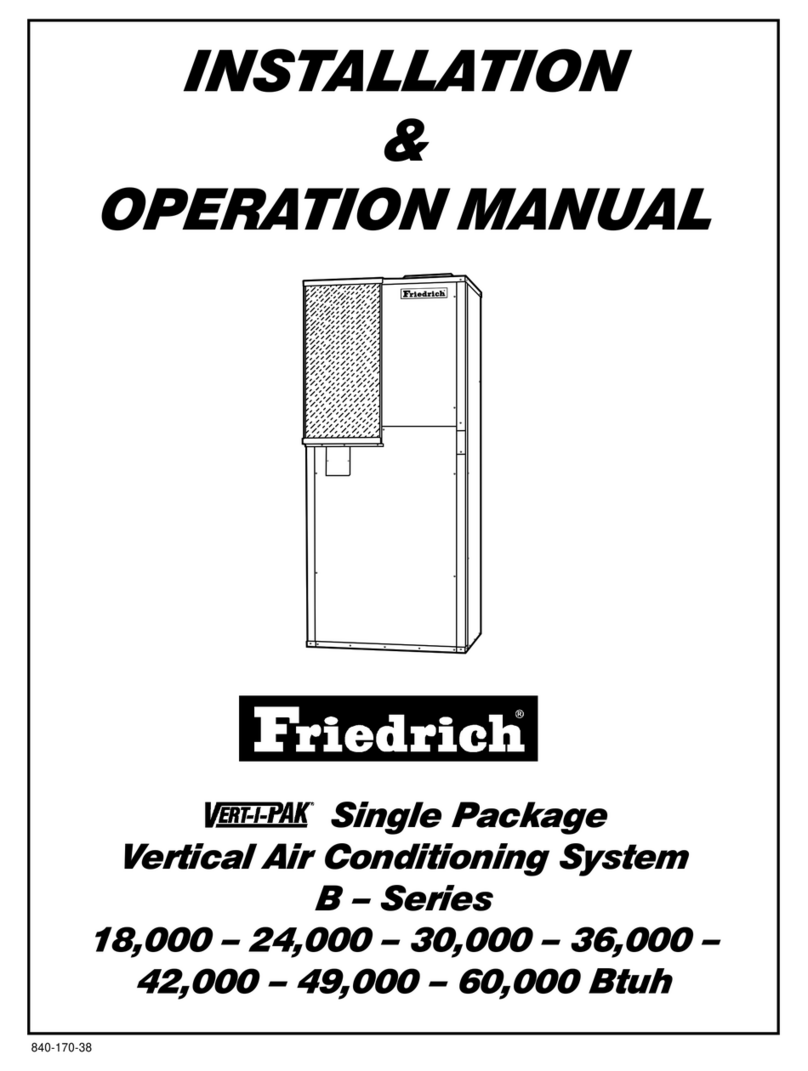
Friedrich
Friedrich 0 Installation and operation manual

GE
GE AEL05 installation instructions

Toshiba
Toshiba RAS-M10N3KVP Series owner's manual

Unitary products group
Unitary products group Sunline 2000 DM180 installation manual
